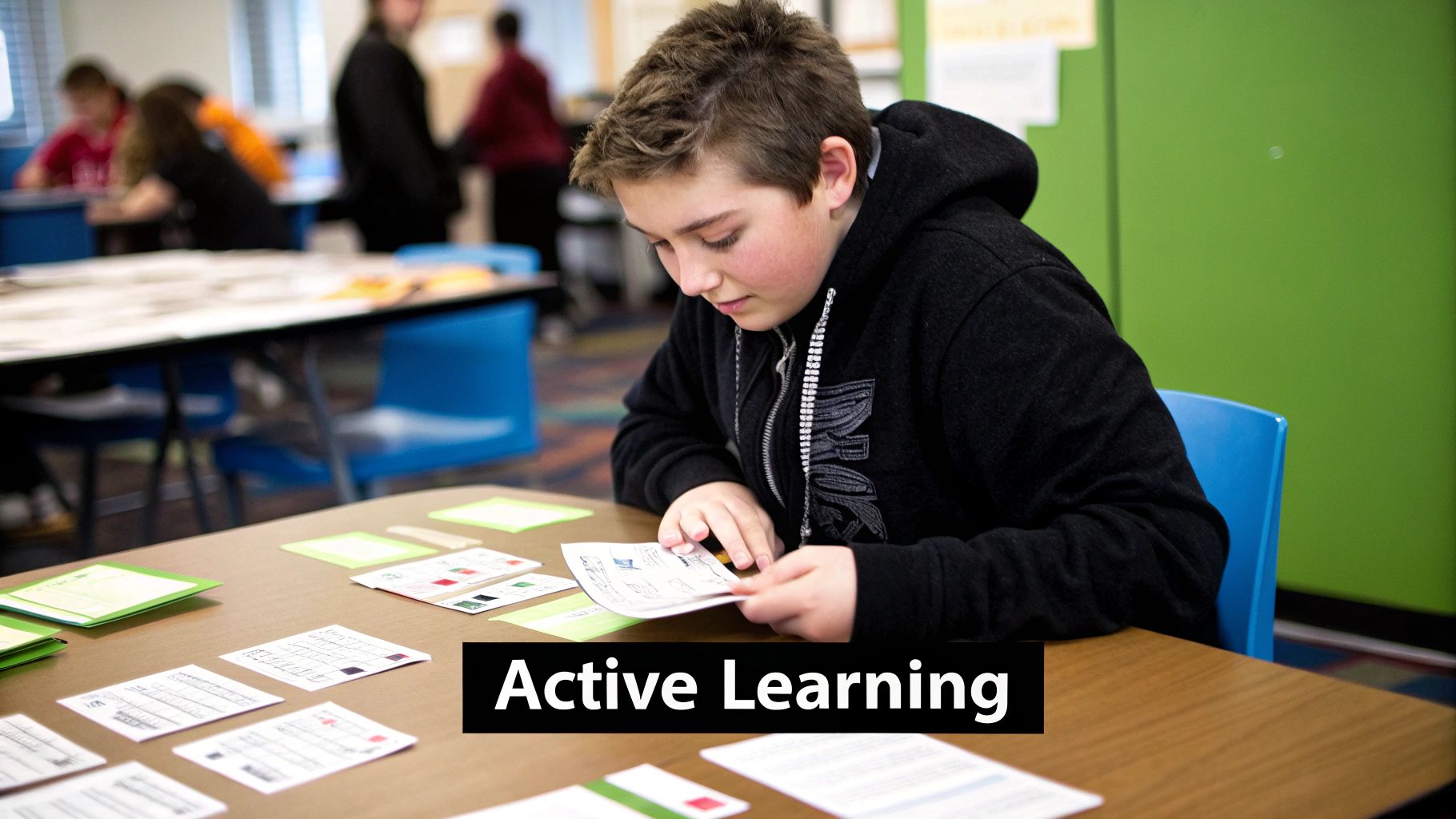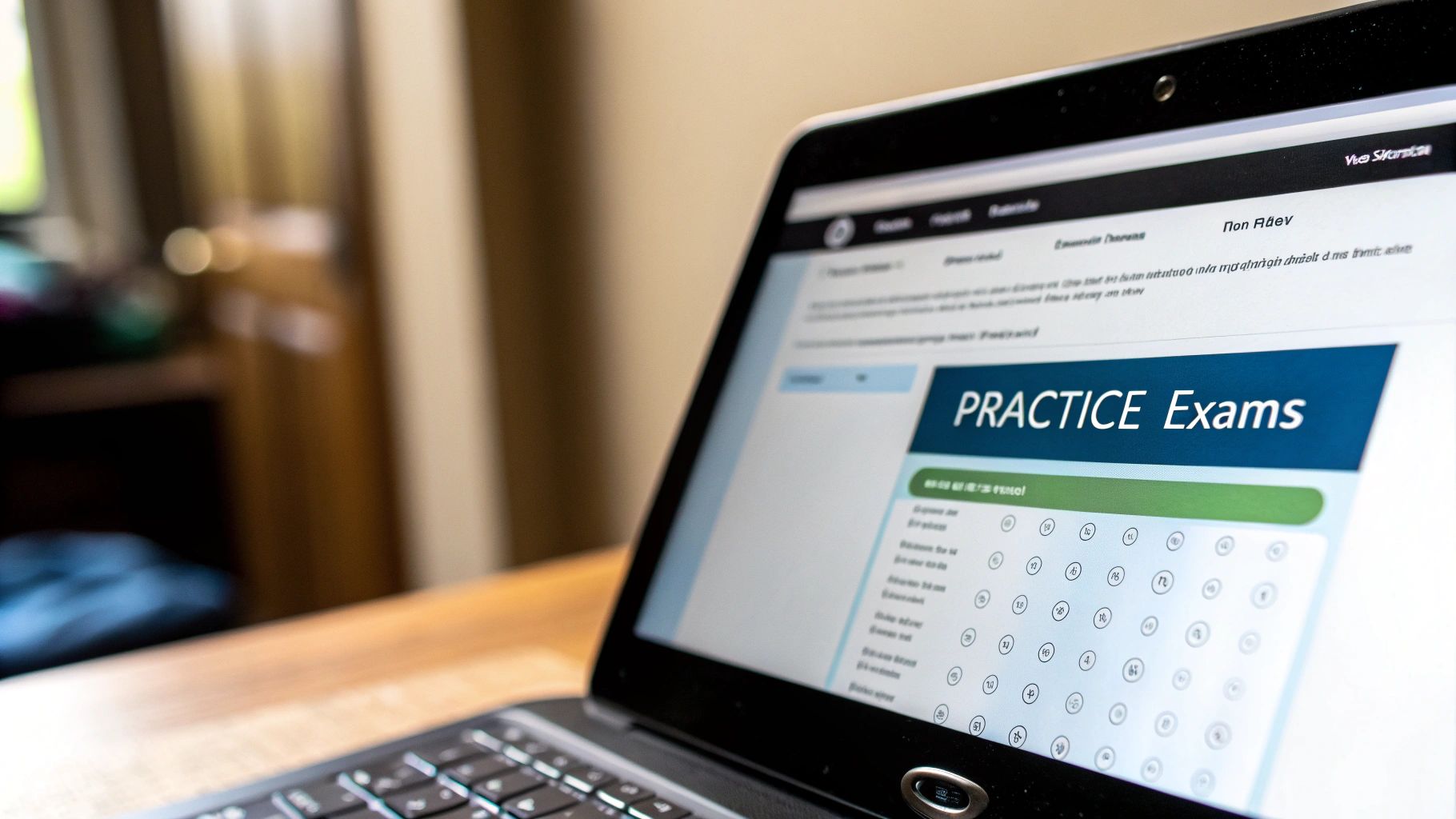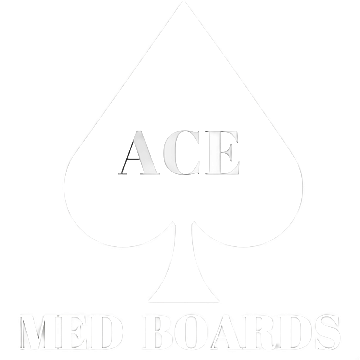Understanding What You're Really Up Against
Before you start building study schedules or picking your go-to resources, let’s get real. The USMLE Step 1 isn't just another final exam. It's a completely different beast that demands a new way of thinking and studying. The habits that got you through your preclinical years, like late-night cramming or just re-reading notes, simply won't cut it here. This exam is less about spitting back isolated facts and more about connecting concepts to solve complex patient cases.
The move to pass/fail has changed the dynamic, but maybe not how you think. It's not a free pass to slack off. Instead, it’s a clear signal to focus on genuine mastery rather than chasing a three-digit score. While the pressure of hitting a specific number is gone, the need for a rock-solid foundation of medical knowledge is more critical than ever for your future clinical rotations and other board exams. This means your approach to how to study for USMLE Step 1 needs to be deliberate, targeting deep understanding over surface-level memorization.
Moving Beyond Grades to True Mastery
Think of it this way: in your classes, you probably studied to ace a test on one subject at a time. For Step 1, a single question can pull from biochemistry, pharmacology, and pathology all at once. It’s all about connecting the dots. A common pitfall is treating Step 1 prep like just another semester of your M1/M2 curriculum. This is a fast track to burnout and wasted effort.
Instead, you need to shift your mindset to that of a future doctor. Every concept isn't just a potential test question; it's a piece of the puzzle you'll use to understand real patients. This mental shift is huge. It turns studying from a chore into a professional responsibility, which can be a surprisingly powerful motivator during those long study months.
Why Your Background Matters from Day One
There is no one-size-fits-all plan for this exam. Your personal journey into medicine—whether you're a US MD student, a DO student, or an international medical graduate (IMG)—shapes what your preparation will look like. Understanding this from the start is the key to setting a realistic timeline and staying encouraged.
This has nothing to do with one group being "smarter" and everything to do with different starting points, curricula, and outside pressures. The performance data tells this story clearly. In 2023, while 92% of first-time US and Canadian MD students passed, the rate was 87% for first-time DO students and 72% for first-time IMGs. The gap is even wider for those repeating the exam.
These numbers aren't here to scare you; they're here to ground your strategy in reality. You can check out more performance data on the official USMLE site. Knowing where you're starting from allows you to create a study plan that fits you, find the right support, and focus your energy where it will make the biggest difference. This reality check is the real first step.
Building Your Study Foundation That Actually Works
Forget the last-minute heroics and marathon cramming sessions that might have worked in the past. Your success on Step 1 is built on a solid foundation of smart systems, not sheer willpower. When you’re figuring out how to study for USMLE Step 1, your daily routine and study methods matter more than anything else. It all starts with building a structure that respects how your brain actually learns and retains information.

From Passive Observer to Active Learner
Let’s be honest: mindlessly highlighting pages in a review book or re-watching lectures feels productive, but it's often a trap. This is passive learning, and for an exam as complex as Step 1, it's one of the least effective strategies. You absorb information without truly engaging with it, making recall nearly impossible under pressure.
Active learning, on the other hand, forces your brain to do the heavy lifting. It’s about retrieving information, making connections, and applying concepts—the skills you actually need on exam day. Here’s what it looks like in practice:
- Self-Quizzing: Instead of re-reading a chapter on cardiac physiology, close the book and try to draw the pressure-volume loop from memory. Explain each phase aloud.
- Concept Mapping: Grab a whiteboard or a large piece of paper and map out the pathways of glycogen storage diseases, connecting the enzyme deficiencies to their clinical presentations.
- Teaching Others: Try explaining a notoriously tricky topic, like the renin-angiotensin-aldosterone system, to a friend or even just to your empty room. The act of articulating it will quickly reveal any gaps in your understanding.
This active approach might feel slower and more difficult than passive review, but that’s the point. The mental effort is what forges strong, lasting neural connections that you can rely on when it counts.
Designing a Schedule for Humans, Not Robots
A common pitfall is creating an aspirational schedule that no human could possibly stick to for more than a few days. Planning twelve hours of intense, focused study every single day is a direct path to burnout. Instead, build a realistic framework that accounts for your actual attention span and energy levels.
The Pomodoro Technique is a fantastic starting point. This method involves studying in focused bursts—typically 25-50 minutes—followed by a short 5-10 minute break. After a few of these cycles, you take a longer, more substantial break. This rhythm respects your brain's natural cognitive limits, helping you stay fresh and engaged throughout the day. Your goal isn't just to put in the hours, but to make those hours count. We've seen how a well-structured plan can make all the difference, and you can explore more detailed frameworks with our USMLE Step 1 study plan guide.
Since the exam shifted to pass/fail in 2022, some students have mistakenly eased up on creating these rigorous systems. However, the data suggests this might be a risky move. Before the change, pass rates for MD students hovered between 91% and 93%, and for DO students, they were between 86% and 89%. After the transition, the pass rate has dipped slightly, with about 90% of first-time takers passing. These insights from the AMA show that a solid foundation is as critical as ever.
The Power of Spaced Repetition
Finally, no study foundation is complete without a system for making sure you remember what you've learned. Spacing out your reviews over increasing intervals—a technique called spaced repetition—is scientifically proven to be one of the most effective ways to move information into your long-term memory.
This is exactly why tools like Anki are so popular among top-performing students. Instead of cramming a topic once and hoping it sticks, you systematically revisit it just as you're about to forget it. This transforms your review process from a frantic, overwhelming task into a manageable, continuous habit that builds both momentum and confidence over time.
Choosing Resources That Won't Overwhelm You
Walking into the Step 1 resource landscape feels like stepping into a bazaar where everyone is shouting that their product is the magic bullet. The reality is, there's no single perfect resource, but there is a perfect combination for you. The biggest mistake students make is resource hoarding—subscribing to everything and mastering nothing. This "shiny object syndrome" leads to analysis paralysis and a shallow understanding of critical concepts. The goal isn't to use every tool, but to select a few high-yield resources and use them to their full potential.
A solid strategy is to build your core around the "big three" that consistently show up in the study plans of successful test-takers: a question bank, a review book, and a spaced repetition tool. This simple stack covers active recall, content review, and long-term retention—the pillars of effective learning. This infographic shows a common time allocation for a focused, dedicated study period.

The data clearly shows that the majority of focused study time is dedicated to just three core resources, emphasizing a "less is more" approach.
The Core Three: Qbank, Review Book, and Flashcards
Your question bank (Qbank) is your primary active learning tool. While UWorld is often considered the gold standard for its detailed explanations and similarity to the real exam, other Qbanks like AMBOSS can be excellent supplements, especially for its integrated library feature. When evaluating a Qbank, look beyond the sheer number of questions. The quality of the explanations is what truly matters. Can you learn the entire concept from the explanation alone? That’s the mark of a great Qbank.
Your review book, most commonly First Aid for the USMLE Step 1, acts as your study bible. It’s not a textbook to be read cover-to-cover but a high-yield framework to organize your knowledge. Think of it as the skeleton; your Qbank and video lectures will add the muscle and connective tissue. A pro tip is to annotate your First Aid with notes from your Qbank reviews, creating a personalized, all-in-one review guide by the end of your prep.
Finally, a spaced repetition system like Anki is your weapon against forgetting. It automates the process of reviewing information at the perfect interval to lock it into your long-term memory. You can create your own cards based on incorrect Qbank questions or use a popular pre-made deck like AnKing. This ensures you’re constantly reinforcing weak areas without spending hours manually reviewing old topics. If you want a deeper look into these methods, you can check out our guide on study techniques for med students.
To help you decide, here's a quick comparison of the essential resources and some popular supplemental tools.
Essential USMLE Step 1 Resources Comparison
Comprehensive comparison of major Step 1 preparation resources including question banks, review books, and video lectures with their key features, pricing, and ideal use cases.
| Resource Type | Best For | Key Features | Time Investment | Cost Range |
|---|---|---|---|---|
| Qbank (UWorld) | Core active learning, exam simulation, and in-depth concept review. | 3,700+ questions, detailed explanations, self-assessments, performance tracking. | High (Primary tool for 4-6+ hours/day in dedicated) | $349 – $799 |
| Review Book (First Aid) | High-yield content consolidation and creating a personalized knowledge base. | Comprehensive outline of testable topics, diagrams, mnemonics. | Medium (Used daily as a reference and annotation hub) | $50 – $60 |
| Spaced Repetition (Anki) | Long-term retention and combating the forgetting curve. | Customizable flashcards, spaced repetition algorithm, pre-made decks (AnKing). | High (Daily reviews, 30-90 minutes/day) | Free (iOS app is paid) |
| Video Lectures (Boards and Beyond) | Building a foundational understanding of all subjects. | 440+ videos, integrated quizzes, follows First Aid structure. | Medium-High (Initial pass through material) | $249 – $549 |
| Pathology Videos (Pathoma) | Mastering pathology concepts with intuitive explanations. | ~35 hours of video, high-yield text, focuses on core principles. | Medium (Especially for pathology blocks) | $99 – $219 |
| Visual Mnemonics (SketchyMedical) | Memorizing pharmacology and microbiology for visual learners. | Story-based visual mnemonics ("sketches") for bugs and drugs. | Low-Medium (Targeted use for memorization-heavy topics) | $300 – $600 |
This table shows how each resource fills a specific niche in your study plan. The core three (UWorld, First Aid, Anki) cover your primary needs, while supplemental resources like Pathoma or Sketchy are specialists you bring in to fix specific weaknesses.
Adding Supplemental Layers Wisely
Once your core is established, you can thoughtfully add supplemental resources to target specific weaknesses. These are your "specialist" tools.
- Video Lectures: Platforms like Boards and Beyond or Pathoma are fantastic for building a conceptual understanding, especially for complex subjects. Dr. Sattar’s Pathoma is legendary for a reason—he makes pathology intuitive. Use these during your initial pass-through of material to build a strong foundation before hitting the Qbank hard.
- SketchyMedical: For visual learners, Sketchy is a game-changer for memorizing pharmacology and microbiology. The visual mnemonics are incredibly sticky and can save you hours of rote memorization. If you can recall a weird cartoon, you can recall the drug's side effects.
The key is to add these layers one at a time. Don’t start with five different video resources. Pick one, see if it fits your learning style, and master it before even considering another. Remember, your goal for how to study for USMLE Step 1 is depth, not breadth, in your resource selection.
Mastering Question Banks Like a Pro
Question banks are the absolute core of any solid study plan for USMLE Step 1. However, there's a world of difference between just doing questions and strategically using them. Many students get trapped in viewing their Qbank percentage as a reflection of their worth, which just leads to anxiety and poor review habits. Let's be clear: the real value isn't in the score; it's in the learning that happens after you hit "submit." Think of your Qbank as your most important learning tool, not a performance metric—at least not until the very end.

Tutor Mode vs. Timed Mode: A Tale of Two Strategies
One of the first choices you'll face in your Qbank is whether to use tutor mode or timed mode. They have completely different jobs, and knowing when to deploy each is key to your success.
Tutor Mode (Your Learning Phase): For the bulk of your prep, especially in the beginning, tutor mode is your best friend. In this mode, you get the explanation immediately after answering a question. This creates a powerful, immediate feedback loop. You answer, see why you were right or wrong, and learn the concept on the spot. It's slower, sure, but the goal here is deep, lasting understanding, not speed.
Timed Mode (Your Stamina-Building Phase): As you inch closer to your exam date, usually in the final 3-4 weeks, it's time to switch to timed blocks. The goal here is twofold: to simulate the real exam's time pressure and to build your mental endurance. Answering 40 questions in 60 minutes is a skill that needs practice. This phase is all about pacing, managing test-day nerves, and training your brain to stay sharp for the long haul.
The Art of Reviewing Your Answers
Getting a question wrong isn't a failure; it's a golden opportunity. The real learning happens in the review. Just glancing at the explanation for the correct answer won't cut it. A deep-dive review is what separates a passing score from a failing one.
For every single question—right or wrong—ask yourself these questions:
- Why was the right answer correct? Can you explain the underlying physiology or pathology in your own words, without looking at the text?
- Why were the wrong answers incorrect? This is often more valuable than knowing why the right one was right. Each "distractor" was designed to trick you. Understanding the trap makes you immune to it next time.
- What was my thought process? If you got it wrong, find the exact point of breakdown. Did you misread the question? Was it a pure knowledge gap? Or did you second-guess yourself and change from the right answer? Naming the type of error is the first step to fixing it.
For instance, if you chose spironolactone for a patient with hyperkalemia, don't just memorize that it's a potassium-sparing diuretic. Dig deeper. Review the mechanism of every diuretic class and understand exactly why a loop diuretic would have been the better choice. This transforms one question into a high-yield review of an entire drug class.
Your approach to studying is critical. While you won't see a number, the USMLE Step 1 is graded on a pass/fail basis, with the passing standard set at a score of 194. Historically, the pass rate for U.S. and Canadian graduates is around 95%, but it can be lower for international graduates. This shows just how important a solid prep strategy is for everyone. You can find more details about the impact of USMLE scores and pass rates to help shape your study plan.
Using Data to Guide Your Study
Modern Qbanks are treasure troves of performance data. Don't let it go to waste. Use your overall percentage and subject-specific breakdowns to steer your content review. If you're consistently bombing cardiology questions, that’s your cue to spend a day hitting that chapter in your review book or watching relevant videos.
This data-driven method makes sure you spend your limited time shoring up genuine weaknesses, not just re-reading topics you already know well. Let your Qbank performance be your personal guide, turning your study plan into a living, responsive tool that adapts to your needs.
Creating Your Personal Study Timeline That Works
One of the biggest myths in med school is the idea of a "perfect" USMLE Step 1 study schedule. The truth? A one-size-fits-all timeline is a recipe for frustration because it ignores the single most important factor: you. Your starting knowledge, your life outside of studying, and even how you learn best will shape your ideal timeline. Trying to cram your prep into someone else's 8-week bootcamp when you need 16 weeks is a fast track to feeling defeated before you even start.

Dedicated vs. Concurrent Studying: Know Your Phase
First, you need to understand the two main phases of preparation: concurrent and dedicated study. Think of them as two completely different seasons of your prep.
- Concurrent studying is what you do alongside your regular classes during your M1 and M2 years. This is the "low and slow" phase. Your goal here isn't to master everything for Step 1, but to build a strong foundation. For example, when you’re in your cardiology block, you might spend an extra hour each weekend doing UWorld questions on cardiac physiology. This simple habit prevents you from having to relearn everything from scratch later on.
- Dedicated studying is the intense, full-time period—usually 6 to 12 weeks—right before your exam where Step 1 becomes your only job. This is where you connect all the dots, relentlessly attack your weak points, and build the mental stamina for a full-day exam. The length of your "dedicated" depends heavily on the strength of your concurrent studying foundation.
Realistically Assessing Your Time Commitment
So, how much time do you really need for dedicated? The best way to start is with a baseline diagnostic test, like an NBME self-assessment. Be brutally honest with yourself. A starting score of 150 requires a very different approach and timeline than a starting score of 190. A good rule of thumb is that a focused dedicated period can often increase your score by 30-40 points, but this varies widely from person to person.
Now, look at your actual calendar. Can you genuinely commit 8 hours a day to focused study, or is it closer to 5 because of family commitments or other responsibilities? A student who can put in 50 quality hours a week might be ready in 8 weeks, while another student might need 12 weeks to log the same amount of effective study time. Forcing 50 hours of study into a 30-hour capacity just leads to burnout, not a better score.
For detailed planning, you might find a time blocking schedule template useful. It helps you visually map out your days, making sure you allocate time not just for content review and Qbanks, but also for crucial breaks. Remember to build in buffer days. Life happens. You’ll get sick, feel exhausted, or just need a mental health day. Planning for these inevitable setbacks prevents one bad day from derailing your entire schedule. It’s about building a resilient plan, not a rigid one.
To help you visualize this, here are a few templates that show how you might structure your time.
Sample Study Timeline Templates
Customizable study schedule templates for different preparation periods (8-week, 12-week, and 16-week plans) with phase breakdowns and milestone checkpoints.
| Timeline Phase | Primary Focus | Time Allocation | Key Activities | Success Metrics |
|---|---|---|---|---|
| Phase 1 (First 30-40%) | Content Foundation | 60% Content Review, 40% Questions | First pass of First Aid/Pathoma/BnB, untimed/tutor mode Qbank blocks. | Completion of foundational video resources, initial Qbank pass started. |
| Phase 2 (Middle 40-50%) | Weakness Remediation | 40% Content Review, 60% Questions | Targeted review of weak subjects based on Qbank data, mixed/timed blocks. | Improvement in Qbank scores for weak areas, >50% Qbank completion. |
| Phase 3 (Final 10-20%) | Exam Simulation | 20% Content Review, 80% Questions | NBME self-assessments, timed UWorld blocks, reviewing high-yield notes. | Consistent passing scores on NBMEs, completion of UWorld Self-Assessments. |
These templates show a common pattern: an initial focus on building a knowledge base, a middle phase dedicated to identifying and fixing weak spots, and a final phase centered on exam simulation and endurance. Your personal timeline should reflect this general progression, adjusted for your unique needs and starting point.
Staying Motivated When the Grind Gets Real
Let's get real about the part of studying that isn't about flashcards or question banks: the mental marathon. It’s that feeling of dread when a practice score is lower than you hoped, the sheer exhaustion that sets in after weeks of non-stop work, and the quiet fear that you'll never learn it all. This isn't a weakness; it's a completely normal part of learning how to study for USMLE Step 1. The trick is to have a game plan for when your motivation takes a nosedive.
Battling Perfectionism and Low Scores
Perfectionism is one of the biggest motivation killers. Seeing a 65% on a UWorld block can feel like a punch to the gut, but that number doesn't dictate your future. Instead of seeing it as a final grade, think of it as a diagnostic tool. A low score is just a big, bright arrow pointing you toward exactly what you need to review next. It's just data, not a judgment on your abilities.
When you're dealing with disappointing scores, try these strategies to keep your head in the game:
- Focus on Your "Why": Take a minute. Remember the reason you chose this path. Reconnecting with that initial passion can be the fuel you need to get through a particularly tough week of studying.
- Track Progress, Not Perfection: Stop obsessing over every daily percentage. Instead, look at your trends over a week or two. Are you getting better in the areas you were weak in? That's the growth that truly counts.
- Celebrate the Small Wins: Did you finally get the coagulation cascade to stick? Acknowledge it. These little victories create momentum and make the long journey feel more manageable.
Building a Resilient Study Environment
The mental aspect is tough enough without adding physical discomfort to the mix. Hunching over a desk for hours leads to back pain, eye strain, and fatigue, all of which drain your focus and positivity. To stay sharp and avoid burnout, think about your physical setup. You can find essential ergonomic desk accessories for improved comfort and productivity that can make a real difference. A good chair or a monitor stand isn't an indulgence; it's a tool for endurance.
It's also vital to spot the signs of study fatigue before it becomes full-blown burnout. If you're reading the same sentence over and over or feel constantly on edge, your brain is signaling for a break. We cover this in more detail in our article on avoiding USMLE exam burnout.
Your Support System Is Your Lifeline
You can't—and shouldn't—do this by yourself. Your support system is absolutely essential, but it has to be the right kind of support. This is about more than just having people to vent to. It's about surrounding yourself with those who get the pressure cooker you're in without adding to it.
This might be a study partner who gets excited about your progress, a non-medical friend who reminds you that life exists outside of First Aid, or family who helps with daily tasks so you can focus. Be direct with your loved ones about what you need. Time and again, students who've recently taken the exam say that struggling during prep is normal and doesn't mean you'll fail, especially if you have a solid support network to lean on.
Final Weeks and Test Day Success Strategies
The last few weeks before your exam call for a major shift in your approach. You're no longer trying to absorb massive amounts of new material. Instead, you're moving into a phase of consolidation, confidence-building, and high-yield review. It’s time to stop chasing every last detail and start cementing the knowledge you've worked so hard to gain. This final stretch is about strategy and polish, not brute force.
The Art of the Taper: Scaling Back Without Losing Your Edge
Just as a marathon runner doesn’t sprint 26 miles the day before a race, you need to "taper" your studying. This doesn't mean stopping entirely, but strategically reducing the volume and intensity. The goal is to avoid burnout and show up on test day feeling fresh, not exhausted. You want to peak at exactly the right moment.
In the final week, your study days should become progressively shorter. The heavy lifting is done. Your focus should now pivot to:
- Rapid Review: Quickly flip through your annotated First Aid, personal flashcards, or a high-yield review deck. Concentrate on fast recall of key facts, formulas, and associations.
- Light Question Blocks: Consider doing one block of questions a day just to stay in the rhythm of test-taking. Don't stress about the percentage; this is just to keep your mental muscles limber.
- Mental Rehearsal: Visualize yourself on test day—calm, confident, and moving efficiently through each block. This simple exercise can do wonders for pre-test nerves.
The day before the exam, your only job is to relax. Do absolutely zero studying. Go for a walk, watch a movie you love, and prioritize getting a good night's sleep. Trust in the months of work you’ve put in. A last-minute cram session will only spike your anxiety and won't meaningfully add to your score.
Test Day Logistics: Planning for a Smooth Experience
Your performance on this eight-hour beast of an exam isn't just about what you know; it's also about how well you manage the day itself. Logistics are a huge part of this. A few weeks before your test, do a practice run to the Prometric testing center. Figure out the route, traffic patterns, and parking. Eliminating this one source of stress on exam morning is a massive win.
The USMLE website offers a detailed overview of the test day experience, including the check-in process and security measures.
This image shows that the check-in routine is similar to airport security. Knowing what to expect—like arriving early and being ready for these procedures—helps you stay calm and focused from the moment you arrive.
Here’s a checklist of what to bring and how to plan your breaks:
- Your ID and Permit: This is critical. Double-check that your identification exactly matches the name on your scheduling permit. There is no room for error here.
- Food and Drink: Pack a lunch and snacks that you know your stomach handles well. This is not the day to experiment. Think protein and complex carbs for sustained energy, not a sugar rush that leads to a crash.
- Break Strategy: You get 60 minutes of total break time. Plan how you'll use it. A popular and effective strategy is to take a short 5-10 minute break after every block to stretch, use the restroom, and grab a quick bite.
Be prepared for the real exam questions to feel harder or more ambiguous than what you saw in your Qbank. This is a normal experience for almost everyone. The key is to not let it shake your confidence. Trust your preparation and just keep moving forward.
Navigating these final weeks and test day requires a specific set of skills. If you're looking for personalized guidance to build that final layer of confidence and fine-tune your strategy, the expert tutors at Ace Med Boards specialize in creating plans for this crucial phase, helping you walk into your exam feeling prepared and in control.
Article created using Outrank

